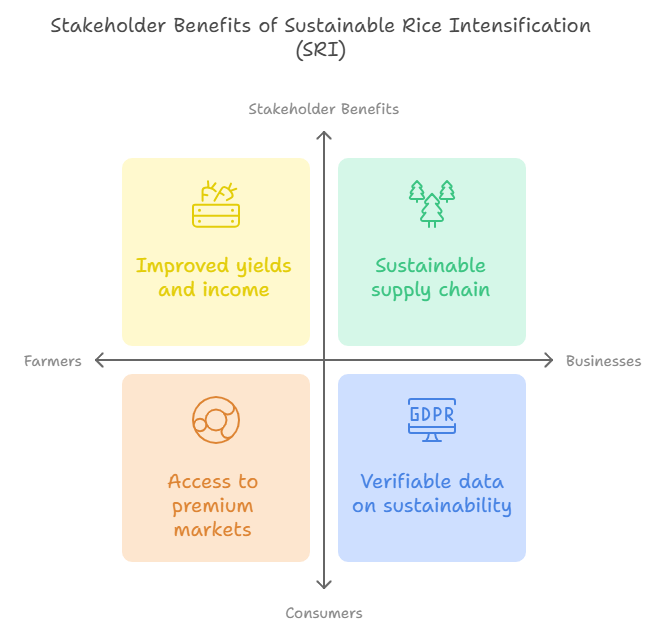Contact: +91 99725 24322 |
Menu
Menu
Quick summary: Explore sustainable rice cultivation with the System of Rice Intensification (SRI). Learn how SRI practices, including alternate wetting and drying (AWD), optimize irrigation, enhance plant spacing, and promote soil health. Discover the environmental benefits of reducing methane emissions and leveraging technology like TraceX for efficient SRI farm management.

Did you know that rice, the staple food for over half the world’s population, is also one of the most water-intensive crops, consuming up to 2,500 liters of water per kilogram produced? With increasing pressure on water resources and climate change exacerbating these challenges, traditional rice farming practices are becoming unsustainable. System of Rice Intensification (SRI)—a sustainable and innovative approach to rice farming that promises to increase yields, conserve water, and reduce environmental impact.
Farmers worldwide are grappling with dwindling water supplies, reduced soil fertility, and the rising costs of fertilizers and pesticides. Conventional rice cultivation practices often contribute to greenhouse gas emissions and degrade ecosystems, threatening food security and farmer livelihoods. In this blog, we’ll explore how SRI is transforming rice cultivation into a more resilient and eco-friendly system.
Key Takeaways
The System of Rice Intensification (SRI) is an innovative and agroecological approach to rice cultivation that aims to optimize yields while minimizing inputs. Focused on enhancing plant and soil health through principles such as reduced plant density, transplanting young seedlings, and improved water and nutrient management, SRI has gained global attention for its potential to increase rice productivity sustainably.
SRI originated in the 1980s in Madagascar when Father Henri de Laulanié introduced the initial concepts. Over the years, practitioners and researchers refined and expanded the SRI methodology, leading to its adoption in various countries. SRI’s evolution reflects a community-driven effort to address the challenges of conventional rice farming, emphasizing ecological principles to achieve higher yields and improved resilience in the face of changing agricultural landscapes.
The System of Rice Intensification (SRI) emphasizes several key components:

One of the notable environmental benefits of the System of Rice Intensification (SRI) is its emphasis on reduced water usage and increased water efficiency. Through practices like intermittent irrigation and maintaining a moist rather than flooded soil, SRI minimizes water consumption compared to traditional rice cultivation methods. This not only addresses concerns related to water scarcity but also contributes to improved water use efficiency in agriculture, a critical factor in regions facing water resource challenges.
SRI’s focus on organic matter incorporation and reduced reliance on chemical fertilizers fosters improved soil health. By promoting natural soil fertility and structure, SRI minimizes environmental impact associated with the use of agrochemicals. The practices encourage a more sustainable and ecologically balanced approach to rice cultivation, reducing the risks of soil degradation and contamination, and preserving biodiversity in agricultural landscapes.
SRI has significant social implications, particularly for smallholder farmers and rural communities. By promoting resource-efficient practices and reducing input costs, SRI can enhance the economic viability of small farms. Increased yields contribute to food security, and the reduced need for expensive agrochemical inputs improves the financial resilience of farmers. Additionally, the emphasis on community participation, knowledge sharing, and local empowerment enhances social capital within rural communities. SRI’s holistic approach not only improves agricultural productivity but also fosters sustainable livelihoods, contributing to the overall well-being of smallholder farmers and rural populations.
Addressing the challenge of rice methane emissions, both Alternate Wetting and Drying (AWD) and the System of Rice Intensification (SRI) offer distinctive approaches with varying scopes and methodologies.
The predominant source of greenhouse gas emissions in rice agriculture results from the prolonged and artificial inundation of fields. By eliminating this aspect, as achieved in both SRI and AWD practices, methane emissions are markedly decreased, showing a reduction ranging from 22% to 64%.
AWD focuses primarily on altering the traditional irrigation regime to combat methane emissions. By intermittently flooding and drying rice fields throughout the growing season, AWD allows the soil to breathe, reducing the activity of methane-producing archaea. This simple yet effective practice directly addresses the root cause of methane emissions associated with flooded rice fields. AWD is a targeted intervention solely modifying the irrigation process.
TraceX’s Farm Management Platform enabled VNV to streamline sustainable rice cultivation practices by offering a comprehensive solution. The platform supported baseline data establishment, implementation of water-efficient Alternate Wetting and Drying (AWD) techniques, and continuous monitoring. This integration empowered VNV to optimize resource usage, enhance sustainability, and ensure transparency throughout their rice farming operations.
SRI, on the other hand, is a more comprehensive methodology that encompasses various agricultural practices beyond irrigation management. While SRI utilizes AWD as part of its approach to reduce methane emissions, it incorporates three additional pillars. These include optimizing plant spacing to minimize competition, transplanting only young seedlings, and focusing on building and maintaining healthy, fertile soil. SRI’s holistic approach aims not only to address methane emissions but also to optimize overall rice cultivation for enhanced yields, soil health, and resource efficiency.
Measurements indicate that AWD, and similarly SRI, can diminish emissions from rice agriculture by almost 5 tonnes of CO2 equivalent emissions per hectare annually. However, the rise in soil organic carbon witnessed in SRI surpasses that of AWD and other traditional rice cultivation methods, owing to the expanded root network characteristic of SRI.

Challenges in the adoption of the System of Rice Intensification (SRI) include :
Technology plays a pivotal role in enhancing System of Rice Intensification (SRI) practices by providing tools for precision agriculture, data analytics, and decision support. Remote sensing and satellite imagery assist in monitoring crop health and optimizing resource use. Mobile applications and sensor technologies facilitate real-time data collection, enabling farmers to make informed decisions about irrigation, nutrient management, and pest control. These technological advancements contribute to increased efficiency, reduced input costs, and improved yields within the SRI framework.
Digital tools supporting SRI include applications like TraceX, which offer farm management solutions, leveraging data analytics for precision agriculture. Innovations such as sensor-based irrigation systems and mobile apps for knowledge dissemination empower farmers with actionable insights. The integration of blockchain can enhance transparency in the supply chain, reinforcing the credibility of SRI practices. These digital innovations contribute to the scalability and effectiveness of SRI by providing accessible and advanced tools for farmers to implement sustainable and technology-driven rice cultivation.
TraceX’s Farm Management Platform can significantly enhance the adoption and efficiency of System of Rice Intensification (SRI) practices in rice cultivation.
Key Features of TraceX for SRI Rice Cultivation
SRI’s innovative techniques, including single seedling transplantation, wider plant spacing, and reduced chemical inputs, aim to optimize yields while minimizing environmental impact. The methodology’s environmental and social benefits, such as reduced water usage, improved soil health, and positive impacts on smallholder farmers, underscore its potential to contribute to more sustainable and resilient agricultural systems. However, challenges in adoption and criticisms highlight the need for ongoing research, adaptive management, and targeted support to maximize SRI’s effectiveness across diverse agroecological contexts. As agriculture navigates the complexities of feeding a growing population while mitigating environmental impact, SRI represents a promising path toward more sustainable and productive rice farming.
SRI is a sustainable rice cultivation method that optimizes water, seeds, and nutrients to improve yields. Unlike traditional practices, SRI involves planting young seedlings with wider spacing, minimal water use through alternate wetting and drying (AWD), and the use of organic inputs. This method reduces resource usage, improves plant health, and enhances productivity without the need for chemical-intensive farming.
SRI reduces water consumption by up to 50% compared to traditional flooded paddy systems, lowering methane emissions—a major greenhouse gas associated with conventional rice farming. It also promotes organic soil fertility through the use of compost and reduces dependency on synthetic fertilizers and pesticides, contributing to healthier ecosystems and combating climate change.
Some challenges include a lack of awareness among farmers, the need for precise management practices, and limited access to training. These can be addressed through:
– Farmer education programs to demonstrate the benefits and techniques of SRI.
– Technological platforms like TraceX, which provide real-time guidance, data-driven insights, and traceability solutions to simplify SRI adoption.
– Support from governments and NGOs in terms of subsidies and technical assistance to scale SRI practices.
